Nobody beats the French in the discipline of drinking champagne, but the britons most certainly try. Rather seriously since they for the ninth year in a row constitute themselves as the unrivalled biggest export market with a record import of 34,9 million bottles. Followed by the States with 20,2 million bottles and Germany with 11,5 millions.
Denmark is not even mentioned, and according to my own experience it is not due to a lack of inclination in either end of the life cycle of the bottle. Rather, as the wife of one of the small mand-and-wife-brands of Verzy put it the other day, Scandinavia is a very difficult market because of its taxes and levies. Myself, I was surprised to learn that a lady like this, who only sells 10.000 bottles per year, even has an opinion about whether it is worth it or not to export to Denmark.
Nobody seems to doubt the British. Regularly we see them with their GB on the tailboards and wheel in the opposite side of the car. But also the export amounts have grown: 40 percent when it comes to number of bottles and 62 percent when it comes to value. Which means that more British drink more expensive bottles. They even seem to create events in order to drink champagne rather than to drink it when the proper events occur. Anyway, that is what Francoise Peretti, who is in charge of the Champagne Information Bureau in Britain, explains to the British winesite Decanter.com.
Enthusiastic Britons or not... there is still a bit of distance to reach the consumer with the record consumption par excellence. Six out of ten bottles of champagne pop in France.
På dansk
Lidt af hvert om stort og småt i Champagne/A bit of this & a bit of that with bubbly regards from Champagne
17 March, 2000
13 March, 2000
Corkchange (dégorgement)

Cool bottles with their new cork and muselet.
Champagne spend the storage time wearing a temporary capsule. This will be replaced with the real cork, before the champagne is dressed up and leaves its cool caves to be sold.
At the same time you remove the plug of yeast leftovers and sediments, that has been formed in the bottleneck after the turning of the bottle according to the established pattern of the remuage. Whether done manually or with a machine.
The actual changing of the cork is called dégorgement. For bigger champagne-businesses this today is mainly done with the help of machines. But smaller husband-wife-companies with a production of a few bottles per year still change the corks manually.

The temporary capsules with their plugs of yeast and sediments.
Basically you pull off the temporary capsule with a special opener. The capsule has a kind of plasticcontainer on the back, which will collect the waste after the remuage. After that you tap the cork and fasten it with the thread of wire - le muselet.
To change the capsule manually - a la volée - require certain manual skills. Obviously, you must work fast, so you do not waste too much of the precious content of the bottle. The pressure is six times stronger inside the bottle than outside, so the bubbles are indeed very much attracted to the freedom on the other side of the sturdy walls of glass. On the other hand you also must not work faster than you are sure, that all the sediments will leave.
With his tool le dégorgeur tears off the temporary capsule. The difference of the pressure will expel the plug of sediments and yeast. With a thumb covering the mouth of the bottle he will prevent as many of the bubbles escaping as he can, until the final cork is secured with the muselet. Depending on his abilities and experience a dégorgeur can put the cork on between 400 and 800 bottles per hour.
Liqueur de dosage
A few of the drops - around a centilitre or so - not even the fastest dégorgeur is able to prevent from escaping. Which then on the other hand creates just enough space in the bottle for a little liqueur de dosage: A blend of normally the same still wine as the champagne is made of and sugar or cane sugar.
This is the last chance of the mixer to adjust the sweetness of the champagne. Champagne is so northern that it geographically is almost on the limits of where you traditionally have grown wine on a major scale. The wines from the area are often acidic, because the grapes get less sun than those from more southern areas. On top of that the bottles do not contain even the slightest bit of sugar, because the yeast cells have eaten it all during the second fermentation. And since even a dry champagne - brut - contains up to 15 gram per litre, it is necessary to add extra after the second fermentation. A sweet champagne can contain up to 50 gram of sugar per litre. And be careful, because it is called sec, which could make the beginner confuse it with a dry one.
Automatic plugging
All in all more than 300 million bottles of champagne were sold last year. With a production of one million bottles per year our cooperative certainly belongs to the middle size producers. Obviously bigger then the many man-wife-brands but a dwarf in comparison with grande marques such as Veuve Clicquot and Moët et Chandon. And since you can deal with the dégorgement with a yearly turnover of a million bottles in three weeks per year, it is not at all enough to invest in your own machines. In stead a team with mobile machinery arrives each of these weeks to deal with the plugging.
The first week of March the machine and its team of seven-eight people is working steady and stubborn greatly accompagnied by the rattling sound of the bottles, "pops", "bangs" and off you go. First station is a rather chilly bath.

The bottlenecks get a cold bath at minus 25 degrees Celsius.
The bottles arrive directly on the pallets from the gyropalette with the neck and the plug of yeast pointing vertically down. Keeping this position they are liftet to a rather chilly bath of halfway arctic temperatures. Minus 25 degrees Celsius is the temperature of the solution, that the bottleneck is lowered into. A stay that will last long enough for the plug of yeast to freeze to ice.
The next station is the automatic pluggin. The icy bottlenecks meet la dégorgeuse.
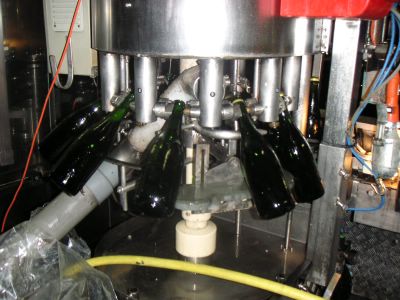
Via a tube the iced yeast is brought to the plasticbag in the left corner..
La dégorgeuse do excactly the same proces as her manual, normally male counterpart. She handles the bottles one at a time. Raises them at the neck from the production line and into a kind of carousel, in which the bottles are tilted slightly one by one in front of the décapsuleuse, that removed the capsule.
The difference of the pressure lets the iced yeast go off in a festive and fizzing "pop". The efficiency of the different carousels vary a lot, but normally you can count on dealing with at least 2.000 bottles each hour. A great deal more than the craftsman of the old days.
The sweetness is balanced
When the plug og yeast has been send off, the open bottles are put back on the production line, where the ratlting roll on to the next station: Dosage. Almost puzzling the rest of the bubbles stay in the bottle. Due to the arctic effect. Even it is only the bottleneck that has literally been dipped into minus 25 degrees Celsius, the chock of this utter coldness has fed into the rest of the bottle, and its content therefore remains nice and quiet during the entire process.

The blend of wine and sugar is drawn off to the right.
Even the loss of champagne is minimal during the plugging, it is still there. The lost centilitre of bubbles will be replaced with a blend of still wine and sugar, the liqueur de dosage. This gives the mixer a possibility of adding a last touch to his wine by chosing the still wine and adjustning the amount of sugar. The wine however will often be the same as the one the champagne is made of.
Sugar, may now ask the unconsecrated reader, at first surprised and then slightly deterred, since today most people by far prefer the dry to the sweet champagne. 92 percent of the sales are the dry brut. However even the brut contains a bit of sugar - 15 gram per litre - and since no sugar is left in the bottle after the second fermentation it is necessary to adjust the sweetness after this proces.
When the champagne has the right taste and contains the number of centilitres it is supposed to, it gets the real cork

"Pop", "bang" and off you go.
This time the cork is to stay, it is secured with the thread of steel and capsule at the top. The latter is a great collectors item here, since the producers are smart enough to change the capsules with the years and qualities.
The bottles travel through another machine, where a kind of ram pushes the cork down the bottleneck and another one secures the muselet.
Thus plugged as it should the bottle of champagne must endure being shaked in all directions in order to blend the bubbles with the newly added sweet wine. A kind of rocking mechanism turns the bottles in all directions, before they once again are send out on a long row in the last bit of production line.
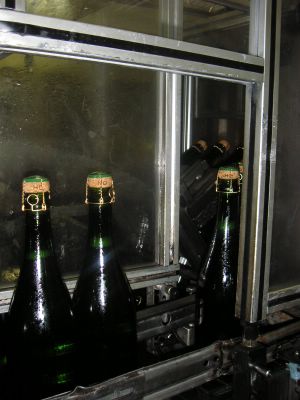
Champagnen rystes sammen med likøren.
The onlu thing left now is to pack the bottles in boxes. Not the final ones though, because the iced neck is not yet ready to be dressed up in gold foil, and before this has happened the champagne is not yet ready to waltz out to please the entire world.

The bottles are lifted off the production line.

Muselets en masse.

Unused cork en masse.
Contents of sugar:
Brut: up to 15 gram sukgar per litre
Extra-Dry: 12 to 20 gr/l
Demi-Sec: 17 to 35 g/l
Sec: 33 to 50 g/l.
På dansk
12 March, 2000
Right movements of the remuage
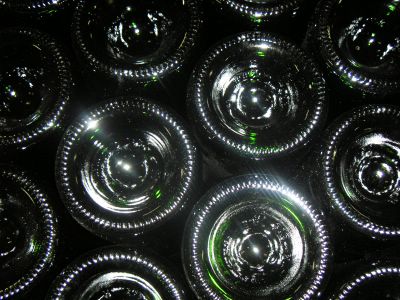
A pallet of champagnebottles turned upside down
At the earliest 15 months after the still wine had yeast and sugar added before being poured onto the bottles, it has fermentated for the second time - the bubbles have been created - and the wine is now anything but still. It has transformed itself to a real bottle of champagne, but before it will be dressed up for the party with gold foil and label, the leftovers from the yeast and chemicals must be removed, and the temporary capsule replaced by the real cork.
An interesting proces, since the carbon dioxide, that has developped in the bottle as the yeast has consumed the sugar, has created a pressure, six times stronger inside the bottle as on the other side of the thick glasswalls.
This pressure is what makes a bottle of champagne come off in a burst of bubbles, if you shake it before opening. Just think about Tour de France, where the winner year after year takes a bath of bubbles on the Champs Elysées as the reward of the endured hardships of weeks. And of course the customers decide how they want to make use of their bubbles. The producers prefer, that the expensive drops stay inside the bottle, until it is sold.
With time and talent advanced methods have been developped to secure this.
A little movement each day
The leftovers from the yeast are heavy and sticky and on top of that they make the champagne cloudy. Which is why they must be removed. However the leftovers are glued to the walls of the bottle, and therefor not that easy to get hold of.
You cannot simply shake the bottle, it could take off, and then all your hours of work would be wasted anyway. Instead the cavists in Champagne a couple of hundred years ago began to riddle the bottles in a certain systematic way. This proces is called remuage, and it was invented by the yellow widow Clicquot-Ponsardin herself and her cavist in charge.

The pupitre is mainly decoration today.
Basically you turn the bottle a little bit each day in a certain period of time and in a certain way day by day raising it a little bit more than yesterday until the bottle has been turned almost completely upside won. These delicate movements will make the sediments at last collect as a plug in the bottleneck. This plug is removed during the process called dégorgement, which is described in another piece.
Doing the riddling is a particular job, it is le remueur, who is the artist behind it, and the pupitre is his keyboard. Wearing his white apron he stands in front of his pupitres. Big pieces of wook with holes, cut in such a way that you can puc a bottle into it and day by day rise it to a more vertical position. You must imagine these pupitres standing shoulder by shoulder in endless long rows through the broad and long chalky caves in Champagne.
Le remueur turns the bottles with both hands, either to the right or to the left. On the footing of the pupitre he records the direction with a piece of chalk. Depending on time and tradition he will rotate the bottle one fourth, one sixth or one eighth. And it must be moved like this twice its own circumference before the leftovers have been collected in the neck. The proces can endure from three weeks to a couple of months. The better the remuer, the better the final result. It takes time to learn the correct twist in the wrist. And only then you can manage the up to 60.000 movements in a day, that several of the grande marques claim their
remueurs can handle in a day.
Modern times however also have arrived in Champagne. The vinification is not covered by the same amount of rules as the growing of the wine, which means that modern methods often are used in the production part of making a bottle of champagne. This development has been taken pupitres in droves up from the deep caves and out on villagestreets and housewalls, where they are used as flowerframes. The gyropalette has taken over the riddling.

The gyropalette contains around 500 bottles.
Automatic riddling
In the gyropalette you put your pallet of 504 bottles, you programme it, push the start button, and then the entire thing is riddled and shaken in less than half the time of the old days. Without any human intervention apart from taking the pallette in and out.
It works gently and yet precise, and it works around the clock, weekends included and without extra payments. On top of that add a great savings in terms of space, since the gyropalette makes the endless rows of pupitre superfluous.
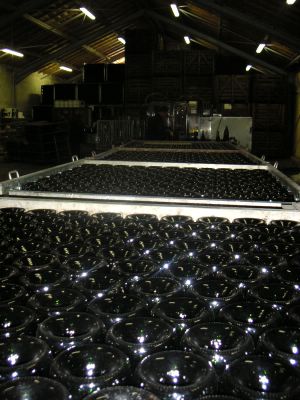
A team of bottles ready for plugging (dégorgement).
Undeniable, computerprograms and pallets do not posess the same romantic appeal as big, white aprons, the quiet rattling of the bottles and the quite right twist of the wrist, which is why the skilled trade of the riddling is still exercised. Several grande marques still riddle their special prestige products manually.
But also the smallest companies still work manually. Husband and wife with a turnover of 10.000 bottles per year of course cannot write off a gyropallette. Some choose to join others in a cooperative, others keep going the manual way in their own small caves.

The computerprogramme: This is how the gyropalette shakes.
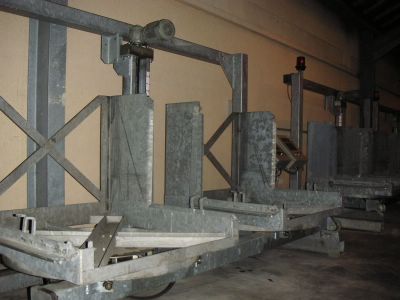
Empty gyropalettes.
På dansk
Top 10 - De store grupper
LVMH
Mærker: Moët & Chandon, Veuve Clicquot-Ponsardin, Mercier, Ruinart, Krug
55,2 millioner flasker, omsætning: 1.664 milliarder euro (2010-tal)
Lanson-BCC
Mærker: Lanson, Burtin Besserat de Bellefon, Boizel, Chanoine, Philipponnat, De Venoge
22 millioner flasker, omsætning: 305,15 millioner euro (2010-tal)
Vranken Pommery-Monopole
Mærker: Vranken, Pommery, Heidsieck & Cie Monopole, Charles Lafitte
20,5 millioner flasker, omsætning: 309,1 millioner euro (2010-tal)
Groupe Laurent-Perrier
Mærker: Laurent-Perrier, De Castellane, Salon-Delamotte, Jeanmaire
10,3 millioner flasker, omsætning: 181,3 millioner euro (2009-tal)
Pernod-Ricard:
Mærker: G.H.3 Mumm, Perrier-Jouët
9,6 millioner flasker, omsætning: 7,064 milliarder ero (2009-tal)
Groupe Roederer
Mærker: Louis Roederer, Deutz
3,5 millioner flasker, omsætning: 113,8 millioner euro (2009-tal)
Remy Cointreau
9 millioner flasker, omsætning: 96,7 millioner euro (2010-tal)
Groupe Thiénot:
Mærker: Thiénot, Canard-Duchêne, Joseph Perrier, Marie-Stuart
Flasker ikke kendt, omsætning: 95 millioner euro (2009-tal)
Groupe Taittinger:
Mærker: Taittinger, Irroy
Flasker ikke kendt, omsætning: 88 millioner euro (2009-tal)
Martel og De Cazanove
Flasker ikke kendt, omsætning 79,4 millioner euro (2009-tal)
Kilde: Tallene stammer fra avisen l'Unions store tema om salgstal 2010, februar 2011.
Det er helt interessant at sammenligne de forskellige huses forhold mellem antal flasker og omsætning. Selvom ikke alle tal er helt sammenlignelige, er det tydeligt nok, at nogle huse tjener væsentligt mere per flaske end andre. For egen regning bemærker, at der er ret stor forskel på, hvor dygtige champagnehusene er til at sælge deres flasker dyrt.
Mærker: Moët & Chandon, Veuve Clicquot-Ponsardin, Mercier, Ruinart, Krug
55,2 millioner flasker, omsætning: 1.664 milliarder euro (2010-tal)
Lanson-BCC
Mærker: Lanson, Burtin Besserat de Bellefon, Boizel, Chanoine, Philipponnat, De Venoge
22 millioner flasker, omsætning: 305,15 millioner euro (2010-tal)
Vranken Pommery-Monopole
Mærker: Vranken, Pommery, Heidsieck & Cie Monopole, Charles Lafitte
20,5 millioner flasker, omsætning: 309,1 millioner euro (2010-tal)
Groupe Laurent-Perrier
Mærker: Laurent-Perrier, De Castellane, Salon-Delamotte, Jeanmaire
10,3 millioner flasker, omsætning: 181,3 millioner euro (2009-tal)
Pernod-Ricard:
Mærker: G.H.3 Mumm, Perrier-Jouët
9,6 millioner flasker, omsætning: 7,064 milliarder ero (2009-tal)
Groupe Roederer
Mærker: Louis Roederer, Deutz
3,5 millioner flasker, omsætning: 113,8 millioner euro (2009-tal)
Remy Cointreau
9 millioner flasker, omsætning: 96,7 millioner euro (2010-tal)
Groupe Thiénot:
Mærker: Thiénot, Canard-Duchêne, Joseph Perrier, Marie-Stuart
Flasker ikke kendt, omsætning: 95 millioner euro (2009-tal)
Groupe Taittinger:
Mærker: Taittinger, Irroy
Flasker ikke kendt, omsætning: 88 millioner euro (2009-tal)
Martel og De Cazanove
Flasker ikke kendt, omsætning 79,4 millioner euro (2009-tal)
Kilde: Tallene stammer fra avisen l'Unions store tema om salgstal 2010, februar 2011.
Det er helt interessant at sammenligne de forskellige huses forhold mellem antal flasker og omsætning. Selvom ikke alle tal er helt sammenlignelige, er det tydeligt nok, at nogle huse tjener væsentligt mere per flaske end andre. For egen regning bemærker, at der er ret stor forskel på, hvor dygtige champagnehusene er til at sælge deres flasker dyrt.
07 March, 2000
Busy times in the wake of miss Thaw

Some wine has not been pruned yet. Now it is time to speed up.
More hours of daylight have lengthened the daily activities in the vineyards around us considerably. Both in the Montagne de Reims and on the road through the Côte des Blancs apparently endless quantities of soiled vans of the brands Renault, Citroën and Peugeut are parked along the rows.
Their content of khaki-coloured and winterwrapped wineworkers begin around 9 AM, and nine hours later many are still there. Not even during the two holy hours of lunch between noon and 2 PM, do they consider to follow their bellies.
Even if it is not more than two weeks ago that king Winter began to shake his quilts thoroughly over Champagne day after day, hardly anyone considers it as more than a bit of playing to the gallery. Then sun is to warm, it freezes to little. Five days ago the snow spread in in a thick and soft layer all over Montagne de Reims. Today we do not even have to remember our rubber boots when crossing the rather water-carrying gutters of the streets of Verzy. The snow is gone, the water is gone. Spring is almost here.

Pruned but not attached: Hoarfrozen Pinot Noir at Verzy.
The official completion dates of the French seasons are the equinoxes. The next will arrive in less than two weeks, and now the wine can wake up whatever day.
But before it better be both pruned and attached to the wires, which means that the deadline starts to flash rather red for several of the jobs in the vineyard during the winterseason.
According to the theory the wine heals better, when the latex has started to mount. The later the better the pruning. You wait as long as possible doing the job and therefor get incredibly busy in the end. Right now.
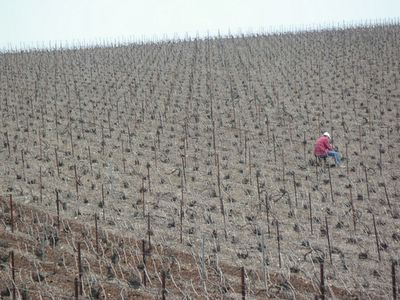
Attaching the wine is timeconsuming too.
Another timeconsuming job follows the pruning. The branches that have survived the pruning must be attached to the wires, each branch with the correct amount of attachments accoring to the AOC-rules (Appellation d'origine controlée).
In the Côte de Blancs they sit shoulder by shoulder in row after row on their low benches with wheels so heavy that they rather easily can push their way over the cover of brushwood without rising. Here in the northern slopes of the Montagne de Reims' they are not as far. Here the main task is still to prune.
Last year the wine produced so many grapes that probably noone remembers ever to have seen anything like it. This year the plants have been left in peace as long as possible in order to give them a chance to recover after the splendid performance. Which is another explanation why the pruning this year has been so late.

The special wheelbarrow made of an old oilbarrel.
This is why you even in the milder Côte des Blancs also see the merry little bonfires steam from the wheelbarrows. It is the cut off branches meeting their last obligation: Helping the wineworkers with their scissors and eagle's beek keep warm
Whether the guy, we met the other day on the road through the Côtes des Blancs-village le Mesnil sur Oger with his capuche covering all of his forehead and a rather hideously smelling fire in the wheelbarrow behind him, was going back for lunch or just changing wineyard, is not easy to know. But the sight most certainly

Blue columns of smoke from burning the cut off wood rise all around.
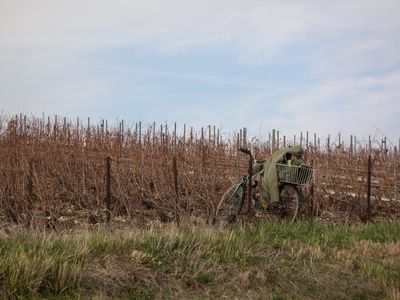
CBicycles are rare on these road with sometimes alphine rises.
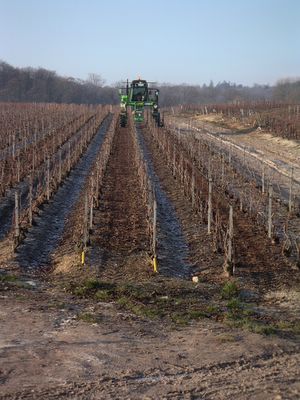
The tractors are busy again spreading chemicals or brushwood.
På dansk
01 March, 2000
Long prospects for vintage 2004
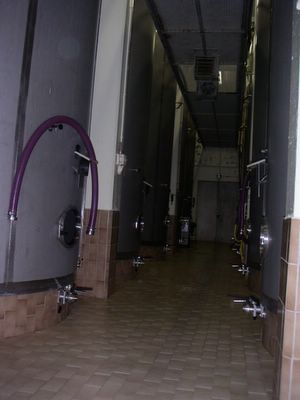
The still wine - no bubbles - is promising.
The still wines are ready in their tanks and barrels and they are promising. They express the special features of each type of grape and the special characteristics
of the area, the balance between acidity and sugar is with a content of sugar close to 9,7 percent close to perfect.
These are indeed promising parameters of a great and probably not blended vintage of 2004. However, the prospects are pretty far in the future.
Long aging
A champagne must always taste the same. If the grapes are not good enough to reach the right taste, you will blend the wine of the year with wines from other years to achieve the targeted taste.
Grapes from very good years such as 2004 can make a great champagne on their own. They are not blended with other years, and they carry the special grading Millésime. This word is written on the bottle with the year.
These Millésime-wines have a greater and more interesting potential than the blended champagnes that are ready to drink straight away. The vintage-champagnes develop more with time, and this is why they are matured longer. They must pass at least three years in the caves before you - according to the AOC-rules (Appellation d’Origine Contrôlée) - can put your Millésime on the etiquette.

Chardonnay is the big crop in the Côte de Blancs.
But do not count on tasting the great grapes from vintage 2004 before around 2010 or even later. If you are able to wait the results are promising.
Typically Chardonnay and Pinot
This kind of positive bulletins have arrived one after the other during the last six months from changing and still more representative sources. Now it is oenologue Luc Chamourin from the winegrowers association, Syndicat géneral des vignerons de la Champagne (SGV), who in the local paper l'Union describes the really great grapes of last year with each type developing the best of its potential in the young wine.
The white Chardonnay-grape has its fine and elegant notes of white flowers and white fruits: White cast iron and acacia, apple, pear and citrus fruits.
The Pinot Noir contributes with red fruits, body and power and with the years a great complexity. Pinot Meunier has its desirable soupleness and notes of red fruits too.
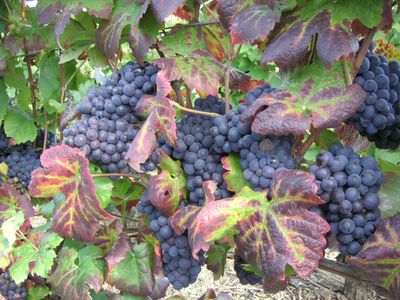
Pinot Meunier is the king in the Vallée de la Marne.
På dansk
Subscribe to:
Posts (Atom)